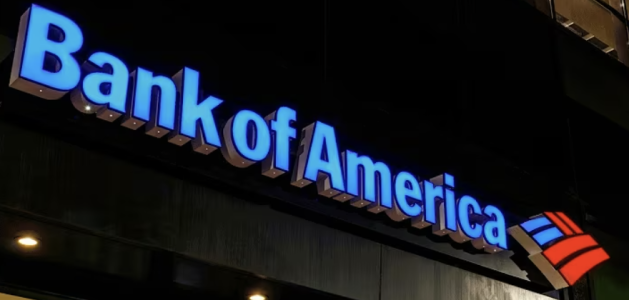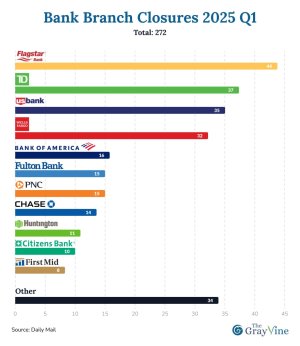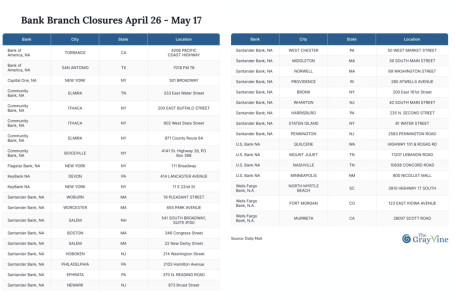Is your local bank next? 36 branches just closed—and more may be on the way
By
Veronica E.
- Replies 0
If you’ve recently passed by your neighborhood bank only to find the doors locked and the lights off, you’re not imagining things.
In just three weeks, 36 bank branches across the United States have closed, leaving many communities—and especially older Americans—wondering what’s next for the future of in-person banking.
For those who remember when a visit to the bank was part of the weekly routine, these closures represent more than just a shift in service—they signal the fading of a familiar, trusted part of everyday life.
And as these changes accelerate, the impact is being felt most in the places where personal connection and face-to-face service still matter most.

A surge in closures: Which banks are affected?
Between April 26 and May 15, eight major US banks filed closure notices with the Office of the Comptroller of the Currency.
These include big names like Santander, Wells Fargo, US Bank, and Bank of America.
New York was hit hardest, losing 10 branches, followed by Massachusetts (6) and Pennsylvania (5).
If you live in these areas, it’s worth checking to see if your local branch is still operating.
Also read: Could your Wells Fargo account be flagged? Here’s how to make sure your money doesn’t get sent to the state
A growing trend—and it’s accelerating
This isn’t a one-time occurrence.
In 2024 alone, over 1,000 bank branches were shuttered nationwide.
And the first quarter of 2025 has already seen 272 more closures.
If this pace continues, experts say thousands of branches could vanish in the coming years.
A recent projection by Self Financial suggests that if current trends continue, the last physical bank branch in the US could close as early as 2041.
That’s less than two decades from now!
Also read: The adventure ends: Why this iconic outdoor store is shutting down every location after 30 years in this troubled city
What’s behind the closures?
The short answer is technology.
Online and mobile banking have made it easier than ever to manage money from home.
Banks, in turn, are cutting costs by reducing their physical footprint.
But that shift isn’t working for everyone.
A recent GoBankingRates survey found that 45% of Americans still prefer in-person banking, and more than half expressed concern about how fast branches are disappearing.
As digital banking grows, so does the risk of leaving people behind—especially seniors, rural residents, and those without reliable internet access.

Also read: Is your local bank shutting down? See the list of 42 branches closing soon
What you can do if your branch closes
If your local branch is closing—or you're concerned it might—there are steps you can take to stay prepared:

Also read: Closing time? Major banks quietly shutter over 100 locations
Looking ahead: Can banks strike a balance?
Andrew Murray, lead data researcher at GoBankingRates, says that even as more people turn to online banking, the public still wants access to in-person services.
76% of Americans believe the banking system needs changes—especially when it comes to preserving community-based options.
As banks evolve, many will need to walk a fine line between efficiency and accessibility.
Technology offers convenience, but it can’t replace the personal trust built over a handshake at the counter.
Read next: Fast food, fast farewell to funds? These 3 chains are draining your wallet!

Have you been impacted by a branch closure? Do you still prefer in-person banking? Or have you made the leap to online banking and have tips to share? Let’s keep the conversation going—because banking may be changing, but community support is timeless!
In just three weeks, 36 bank branches across the United States have closed, leaving many communities—and especially older Americans—wondering what’s next for the future of in-person banking.
For those who remember when a visit to the bank was part of the weekly routine, these closures represent more than just a shift in service—they signal the fading of a familiar, trusted part of everyday life.
And as these changes accelerate, the impact is being felt most in the places where personal connection and face-to-face service still matter most.

As branch closures rise, even long-standing banks like Bank of America are scaling back in-person services. Image Source: YouTube / ABC7 News Bay Area.
A surge in closures: Which banks are affected?
Between April 26 and May 15, eight major US banks filed closure notices with the Office of the Comptroller of the Currency.
These include big names like Santander, Wells Fargo, US Bank, and Bank of America.
- Santander led with 28 branch closures.
- Community Bank followed with 5.
- US Bank and Wells Fargo announced 4 and 3 closures respectively.
- Other institutions like Capital One, Flagstar, and KeyBank also made the list.
New York was hit hardest, losing 10 branches, followed by Massachusetts (6) and Pennsylvania (5).
If you live in these areas, it’s worth checking to see if your local branch is still operating.
Also read: Could your Wells Fargo account be flagged? Here’s how to make sure your money doesn’t get sent to the state
A growing trend—and it’s accelerating
This isn’t a one-time occurrence.
In 2024 alone, over 1,000 bank branches were shuttered nationwide.
And the first quarter of 2025 has already seen 272 more closures.
If this pace continues, experts say thousands of branches could vanish in the coming years.
A recent projection by Self Financial suggests that if current trends continue, the last physical bank branch in the US could close as early as 2041.
That’s less than two decades from now!
Also read: The adventure ends: Why this iconic outdoor store is shutting down every location after 30 years in this troubled city
What’s behind the closures?
The short answer is technology.
Online and mobile banking have made it easier than ever to manage money from home.
Banks, in turn, are cutting costs by reducing their physical footprint.
But that shift isn’t working for everyone.
A recent GoBankingRates survey found that 45% of Americans still prefer in-person banking, and more than half expressed concern about how fast branches are disappearing.
As digital banking grows, so does the risk of leaving people behind—especially seniors, rural residents, and those without reliable internet access.

A growing trend—dozens of US bank branches shut their doors in the first quarter of 2025, leaving many communities with fewer in-person banking options. Image Source: The GrayVine / The Daily Mail.
Also read: Is your local bank shutting down? See the list of 42 branches closing soon
What you can do if your branch closes
If your local branch is closing—or you're concerned it might—there are steps you can take to stay prepared:
- Check your bank’s website or call for closure announcements or relocation plans.
- Explore alternatives like credit unions, which often have strong community ties and maintain local branches.
- Get comfortable with digital tools—many banks offer free classes or tutorials to help older customers navigate mobile and online banking.
- Speak up—if your local branch matters to you, let the bank know. Community feedback has, in some cases, influenced decisions to keep locations open.

Between April 26 and May 17, 2025, these bank branches across the US closed, Image Source: The GrayVine / The Daily Mail.
Also read: Closing time? Major banks quietly shutter over 100 locations
Looking ahead: Can banks strike a balance?
Andrew Murray, lead data researcher at GoBankingRates, says that even as more people turn to online banking, the public still wants access to in-person services.
76% of Americans believe the banking system needs changes—especially when it comes to preserving community-based options.
As banks evolve, many will need to walk a fine line between efficiency and accessibility.
Technology offers convenience, but it can’t replace the personal trust built over a handshake at the counter.
Read next: Fast food, fast farewell to funds? These 3 chains are draining your wallet!
Key Takeaways
- Major US banks closed 36 branches in just three weeks, with Santander accounting for 28 closures—the most of any institution.
- New York, Massachusetts, and Pennsylvania were the hardest-hit states during this wave of closures.
- Experts warn that if current trends continue, all physical branches in the US could close by 2041.
- Despite the shift toward digital banking, 45% of Americans still prefer in-person service, and 76% believe the banking system needs reform.
Have you been impacted by a branch closure? Do you still prefer in-person banking? Or have you made the leap to online banking and have tips to share? Let’s keep the conversation going—because banking may be changing, but community support is timeless!






